In heating systems, both water and non-freezing fluids can be used - antifreeze. About their merits and disadvantages and will be discussed.
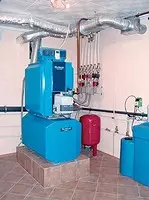
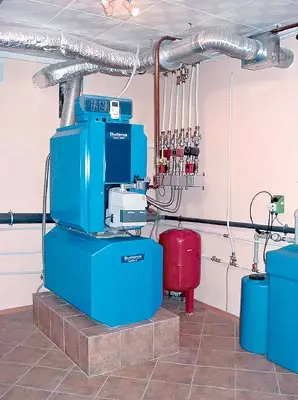
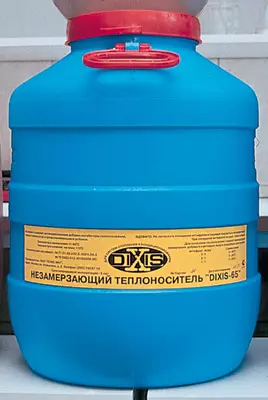
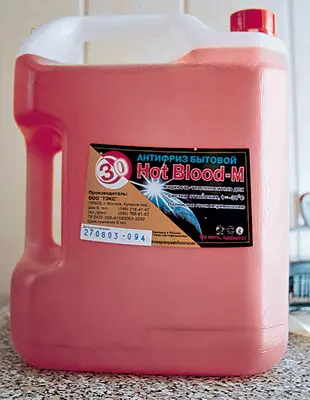
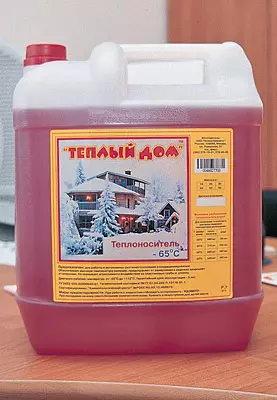
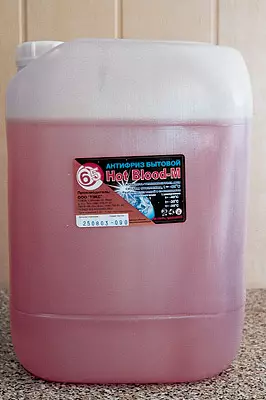
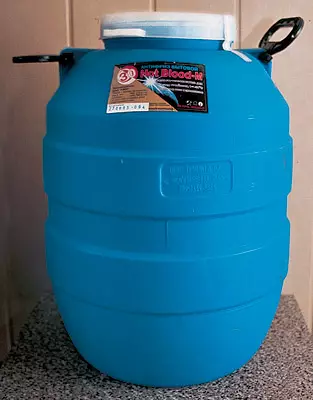
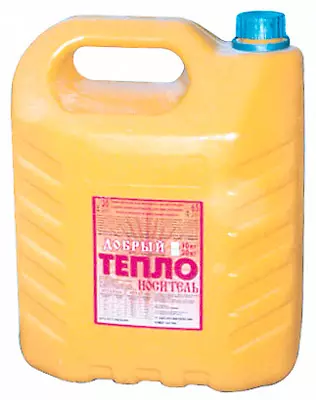
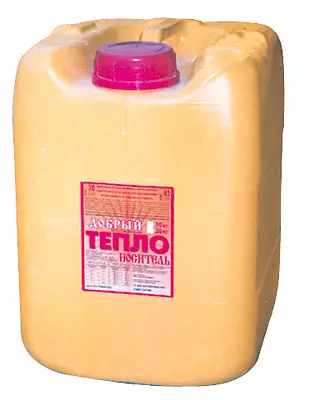
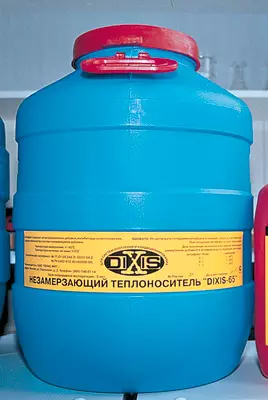
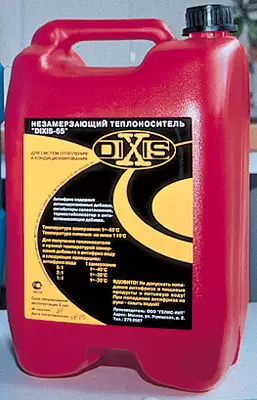
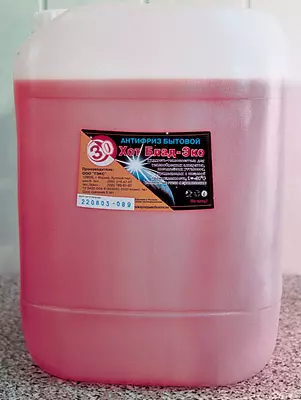
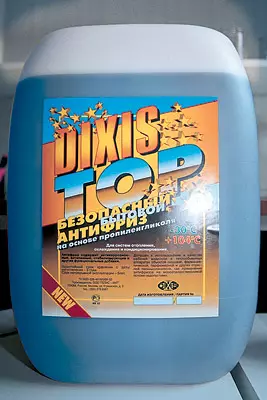
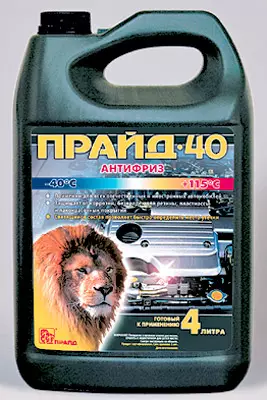
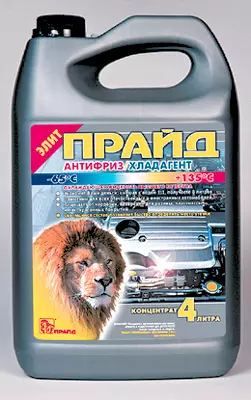
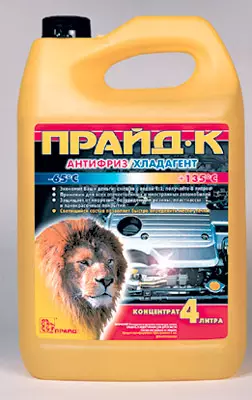
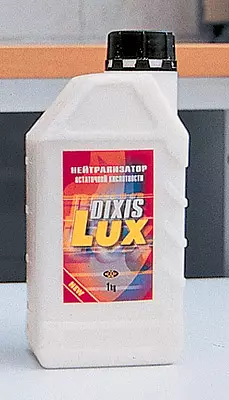
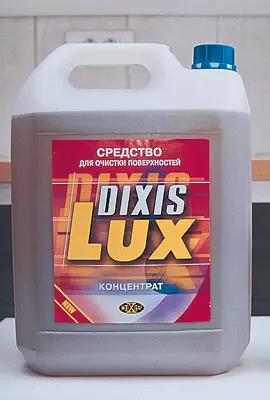
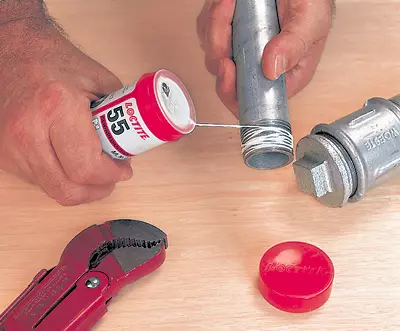
As is known, both water and non-freezing liquids can be used as a coolant in heating systems. Each of these coolants has its advantages and disadvantages. We will tell about them today and tell.
Water with its ability to accumulate when heated and give a large amount of heat when cooled, is an excellent coolant. It has good fluidity and therefore easily circulates through the heating system. In addition, water is always at hand, and if you need to add it to the heating system, there are no problems. It is also important that it is an environmentally friendly substance. Consequently, the possible leakage will not cause an "ecological catastrophe" on the scale of a separate house. But! All these advantages are leveled by one significant disadvantage of the freezing of water in the system and, as a result, the withdrawal of the latter failure (the house with the turned off, but the filled heating system will not leave in the winter). Another disadvantage can be considered the need to change the chemical composition of water before using for heating (for example, due to an increased concentration of iron, oxygen, stiffeners, etc., see the article in N 1 of our magazine for this year). In addition, as it is neither preparing, anyway, corrosion of all metal parts of the heating system occurs.
Antifreeze (from the English. Freeze- "freeze", with the "anti" prefix, meaning the opposite) - this is not a liquid of a certain chemical composition, but a collective concept denoting any low-chamber fluids used to cool the internal combustion engines and various installations (including Heating systems) operating at temperatures below 0s.
Undoubted advantages of antifreezes include "non-freezing" at minus temperatures. Not that they do not freeze at all, it simply does not happen to them in the usual (household) understanding. Introduction from the water, they form not crystalline, but if you can say that, amorphous structure. In this case, the antifreeze does not increase the volume, and therefore does not destroy (not "defects") the heating system. When increasing the same temperature, it reappears into a liquid state and can perform its functions. It is this property and makes antifreeze almost indispensable, if in the winter in the house do not live, it is not necessary to drain the heating system. And, it means that it appears, having arrived at the weekend, quickly protruding the room. However, on this advantage and end, and numerous flaws begin. The temperature range of the temperature is 10-15% the heat capacity of the household antifreeze is 10-15% lower than that of water, therefore, it harms it worse and gives warmth. For the consumer, this means the need to acquire more powerful (and therefore more expensive) radiators for the heating system. The antifreeze viscosity is also 4-5 times higher than that of water, it means that it will be more difficult to circulate it in the heating system (the estimated flow rate of the circulation pump should be taken by about 10% more, and the estimated pressure is 60% higher). And the coefficient of thermal expansion has more than that of the water, therefore, in order to avoid the problem of "convulsion", the open system will have to be able to install the expansion tank of the larger volume. That is why experts in one voice say: if the antifreeze is supposed to use in the system, it is initially necessary to "count" it is precisely on a spontaneous replacement of water with a different coolant is fraught with large troubles.
In addition, antifreeze can not be overheated, since this leads to irreversible changes in its chemical composition and, as a result, to the loss of initial physical properties. And aggressive antifreeze, as they say, does not measure contact with galvanized surfaces (the chemical reaction resulting from such a neighborhood not only changes the composition of antifreeze, but also causes the formation of an extremely brown sediment, which is capable of blocking the operation of the system) and easily "Eat" ordinary rubber gaskets, which in the "water" heating system would serve for quite a long time (no wonder all decent producers of radiators are used in their products a gasket from chemically stable materials - paronite, etc.). There are some more specific features depending on antifreeze. Not all of them are environmentally friendly. The circulation accessional system under certain conditions foams, which causes some restrictions on the capabilities of balancing the heating system and adjust the comfort mode using thermostats. Kednostats should be attributed and the need to keep a permanent stock of antifreeze in case, if you need to add it to the system (for example, when leakage).
Before filling the coolant to the old system, it is necessary to pre-wash it with liquid for cleaning surfaces, for example, Dixis-Lux, SuperTex or other similar solid. For faster removal of air bubbles from domestic antifreeze, it is recommended to withstand it without pressure within 2-3 hours.
Replacing water to household antifreeze can only if this is not prohibited by the boiler manufacturer. For example, Proterm (Czech Republic) deprives the owner of the right to warranty service if any antifreeze is covered in the system, which is recorded in the warranty coupon.
What antifreeze should be used in the heating system? The automobile "Tosol" does not fit here, since it has additives that are not allowed to use in residential premises. Saline solutions (type "Arctic" and "asol"), although they freeze at lower than water, temperatures, are also not suitable, as they have increased corrosion activity and with the time "settled" on the surface of pipes and heat exchangers (for example, in Heating systems with boilers AOGV and ACGV, manufactured by the Zhukovsky Machine-Building Plant, the use of the "Arctic" is prohibited categorically). It follows the so-called household antifreeze-coolants specifically designed for heating systems. What is this substance and what are they characterized?
Currently, antifreeze on the basis of aqueous solutions of ethylene glycol was obtained in Russia and abroad. In case of cases, such a solution contains 65% of ethylene glycol and 31% of water (the remaining 4% - inhibitors' additives). This product, which is considered optimal in heat-technical characteristics, is never reslaring, does not freeze to the temperature -65 ...- 70s, and ethylene glycol from it almost does not evaporate. But in order to fulfill its main function (heat transfer), antifreeze should not only have a satisfactory thermal conductivity, but also not boil in the operating temperature range, do not foam, be chemically stable (do not form deposits on the surface of the system) and not destroy structural materials. These tasks help him solve various additives: inhibitors of corrosion of metals, anti-loss agents, etc., constituting about 4% of the weight of the solution.
The modern Russian market offers mainly antifreeze of domestic production. Even such well-known products like Antifrogen N and Inibahel of German production, we practically did not fit because of high cost. Aza them gradually disappeared from the sale and other imported formulations, providing domestic producers with almost undivided power in the market. Antifreeze can be sold as in the form of a concentrate (95% ethylene glycol) and already ready for use - diluted water, which is appropriately reflected in the marking of the product - the number of the beginning of crystallization (as a rule, 30 or 65) is indicated or the word "concentrate" is set. . Many consumers to facilitate transportation prefer to acquire concentrate or antifreeze "Pocconsentary" (with a freezing temperature -65С, used without dilution, except in the extreme north) and to top up with water in place. For example, when diluting with water antifreeze with marking "65" in proportion 2: 1 (2 parts of antifreeze and 1 part of the water), a coolant with a temperature of the crystallization of the crystallization is -30c, when diluted 1: 1, the coolant with the temperature of the start of crystallization -20c. Those who prefer not to dilute on the spot are buying a finished product, and if the temperature of its freezing does not suit, ordered antifreeze from the manufacturer with the required characteristics, this possibility is also there.
It seems to be simple and good. But ... Ethylene glycol, which is part of antifreeze, when the person gets into the body becomes "poison" (refers to the third hazard group) - a disposable "reception" of only 100 ml of this substance can become a deadly dose for an adult. That is why antifreeze on such a basis is recommended for use exclusively (!) In closed heating systems (with a closed expansion tank). And you should not give in to the assurance of some grief-installers of heating systems that are convincing customers, as if an open tank on a ventilated attic no danger in itself is not tatt.
But what about the open expansion tank)? It is hundreds of thousands of summer houses throughout Russia, if not millions. For them, the exit is to use antifreezes not on the basis of ethylene glycol, but on the basis of propylene glycol, which, with the practically the same properties, absolutely non-toxic (since 1996, the transition to propylene glycol antifreeze began to transition to propylene glycol antifreeze. Here they can be boldly to apply in open systems. True, they cost 2-2.5 times more expensive than ethylene glycol. (For reference: if the liter of antifreeze based on ethylene glycol on the freezing temperature is 65С costs from 16 to 25 rubles, then the price is similar by properties, but on the basis of propylene glycol - 54-57 rubles) more than half a year the rise in raw materials prices In the global market caused the rise of prices for antifreeze on a polypropylene basis on average by 40%. As a result, due to a sharp drop in sales volumes, the well-known global brands of such antifreeze simply stopped appearing in the Russian market, which did not hit the scope before. The domestic manufacturers formed niche have not yet been filled with a sufficient extent, because on sale "safe" propylene glycol antifreeze is rare. But it seems that the demand for him will soon increase - Russian consumers will revise their views on the problem of environmental safety.
Our review provides a comparative table in which, in addition to the density and heat capacity (at temperatures of 20 and 80c), as well as boiling temperatures and the beginning of crystallization, we specifically turned on 3 important for cooling fluids, but not widely published indicators for which you should pay close attention.
Corrosion impact on materials used in the heating system (copper, brass, steel, cast iron, aluminum, solder, etc.), expressed in g / m2 per day. According to the existing GOST, the values of this indicator should not exceed the following: copper, brass, steel, cast iron, aluminum- not more than 0.1; Solder is not more than 0.2. Strong antifreeze These values are essential (at 10, and even 20 times) below. And what they are less, the longer the heating system will live.
The foamability is calculated using a special procedure (through a certain volume of antifreeze at a fixed temperature, air at a given speed is passed for 5 minutes) and is expressed in the height of the foam cap in centimeters. According to GOST, the height of this "cap" for ready-to-use liquids should not exceed 30 cm. The set time for the disappearance of the foam is not more than 3 s. High foam hat and a great time of its settlement say that antifreeze is not very high in front of you and its manufacturers saved on the addition of the anti-speaking agent.
Impact on rubber parts and gaskets. If the GOST is allowed for swelling of rubber by no more than 5%, then when using good antifreeze, it does not exceed 0.5%.
Where can be familiar with the mentioned indicators if you find an antifreeze that has not included in our review? Unfortunately, they are rather difficult to find them in any certificates for products. But they are indicated in technical documentation, which every self-respecting self (and buyer!) The manufacturer accompanies its products, providing sellers. Therefore, do not hesitate to ask the presence of such documentation in the store when choosing antifreeze, and if it is not and never happened, it is better to give up the purchase.
Specialist comments
Explains the head of the heating instrument and heating systems of the WGUP "Niizantehniki", a member of the Presidium of NP AKOK, Candidate of Technical Sciences Vitaly Ivanovich Sasin:
- The information set forth in the review certainly deserves close attention. And not only from consumers, but also from experts. I, in turn, would like to make a number of additions to it, which, in my opinion, will be useful for both readers of your magazine and for all who are interested in the features of the use of antifreeze in heating systems.
one. When using domestic cast iron radiators, antifreeze should be used extremely careful, unfortunately, in radiators, it is often not the tires that are provided for by the technical documentation. Some grief-producers are used for the manufacture of gaskets hoses whose rubber antifreeze eats extremely quickly.
2. Many manufacturers argue that non-ethylene glycol evaporates from antifreeze, but only water and therefore these antifreeze are practically not dangerous. Approval This is no longer confirmed and controversial, since the boiling point in ethylene glycol is twice as high as the water. But, be that as it may, if ethylene glycol antifreeze is flooded into the system, its evaporation from an open expansion tank should be minimized, installing a wooden float in it, which closes the entire surface. That is, despite the statement of harmlessness, foreign manufacturers of antifreeze are advised to come.
3. The antifreeze heating systems can be applied far from all membrane expansion tanks, not all the rubber used in them will endure "communication" with such a coolant. Therefore, choosing an expansion tank, you need to make sure that it is designed to work with antifreeze.
four. We have encountered these studies with the fact that during the dilution of the concentrate of some antifreezes used for this "local" water can give a reaction accompanied by a precipitate. We are mainly additives, so necessary antifreeze. To insure against such a phenomenon, it makes sense to either acquire a ready-to-use antifreeze that does not require dilution, or use distilled water to dilute.
five. Some thermostats, widely used in heating systems, have two setup scales: "Labor" (it seems it and it also uses the consumer) and the "mounting" (hidden inside the thermostat and the installers available only). The "mounting" scale adjusts the discovery of the diaphragm for the passage of the coolant, and if it is installed on position with a minimum opening (position 1 or 2 of 7-8 available), then a rather narrow hole is obtained, followed by a sharp extension. The coolant passage through such a diaphragm leads to the air separation and, as a result, to the formation of air traffic or foaming. For water, this phenomenon is simply unpleasant, but for antifreeze, it is completely unacceptable. Therefore, if antifreeze will be used in the heating system, the "Mounting" setting should include installation to a position, at least 3 (as well as above). And for such a setting it is necessary to trace more at the stage of installation of thermostats.
6. No matter how good automatic air vents, in antifreeze heating systems, it is better to use manual devices. This is associated with the possibility of foaming antifreeze. The paticycled recommendations have not yet been enshrined, but the practice of exploitation has already fully confirmed it.
7. When installing heating systems with steel pipes to seal threaded compounds, it is categorically imputed to apply linen pass in a pair with paint. Valid dreams from water, antifreeze does not cause flax raising. He just "eats". For installation it is better to use special sealants, for example, Loctite (Henkel Concern): Loctite-55- Ready to use Unautheated sealing fiber from complex threads, covered on pipes of pipeline threads directly from a compact container, which is equipped with an integrated knife (container cost- $ 9.5 ; enough for 150 threaded compounds 1/2 "), Loctite-542-single-component threaded sealants, with the polymerization of which a rigid insoluble plastic mass is formed, filling the threaded clearance (the cost of packaging (10 ml) is $ 9.5; enough for 150-200 threaded compounds). Similar sealants are available in the range and other firms. Of course, these products are not very cheap, but their use is fully justified by the reliability of installation.
eight. Before pouring antifreeze into the system, it must be rinsed with special compositions. The "sets" manufactured for such treatment include 2 components - washing (acid composition) and a substance that neutralizing the action of the washing acid. The operation must be carried out before the first fill of antifreeze into the system, especially after use as a coolant of water. Otherwise, there is a risk that the antifreeze "exhibits" rust and scale and the discovered deposits simply score the pipes of the heating system.
nine. Due to the evaporation of antifreeze in open systems, it is often necessary in its topics. If there is an antifreeze previously based on the antifreeze system, then there will be no problems. If there is no stock, it is worth purchasing and applying exactly the antifreeze that was previously used. The "new" coolant can be added only if you are fully confident that it is absolutely compatible with the "old" - if they are incompatibilities, there is no precipitation of some (or even all) in the antifreeges of additives. The consequences of the output of additives from the composition may be unpredictable. Therefore, if there is no confidence in the full compatibility of the components, it is better to simply add to the system distilled water or completely merge the "old" antifreeze, rinse the system and only then use the "new".
And last. A number of presented recommendations is based only on practical experience and requires a deeper study and consolidation in recommendations. Who should conduct these studies and what funds are complex. Most likely, it is necessary to combine government funding with financing from those interested in conducting such studies of antifreeze manufacturers.
| Comparable indicators | Manufacturing firm | |||||||||
|---|---|---|---|---|---|---|---|---|---|---|
| "PRAID", Moscow | "TKS", Moscow * | "Fort", Moscow ** | Himavto, Moscow | "GELIS-INT", Moscow | PTK T-S, St. Petersburg | "Prima Lex", Moscow | ||||
| Brand Antifreeze | "PRIUD-40" / "PRIDE-K" / "PRIDE ELITE-K" | "Hot Blood-30m" / "Hot Blood-65m" | "Hot Blood-30 Eco" / "Hot Blood-65 Eco" | "NORD-K" / "NORD-65" | "Warm house-65" | Dixis Top. | DIXIS-30 / DIXIS-65 | Golf Stream-30 / Golf Stream-65 *** | "Argus Hatdip" / "Argus Galan" | "Argus Ekovarm-65" / "Argus Ekovarm-30" |
| The foundation | Ethylene glycol | Ethylene glycol | Propylene glycol | Ethylene glycol | Ethylene glycol | Propylene glycol | Ethylene glycol | Ethylene glycol | Ethylene glycol | Propylene glycol |
| Density, g / cm3, at temperatures: | ||||||||||
| 20с | 1,080 / 1,134 / 1,134 | 1,062 / 1,086. | 1,045 / 1,048. | 1,12 / 1.08. | 1,085 | 1,040. | 1,06 / 1.09. | 1,06 / 1.09. | 1,09 / 1.08. | 1.05 / 1.04. |
| 80s | - | 1.05 / 1.05 | 1.08 / 1.00 | - | - | 0.99 | 1,03 / 1.05 | - | 1.05 / 1.04. | - / 0.99 |
| Boiling point, C, at 760mm Hg. | 115/135/135 | 106/115 | 108/110 | 189/12. | 112. | 106. | 106/111 | 108/112 | 110/110 | 109/106. |
| Crystallization start temperature, with | -40 / -37 / -37 | -33 / -68 | -35 / -65 | -70 / -65 | -65 | -32 | -32 / -66 | -32 / -67 | -65 / -65 | -63 / -32 |
| Heat capacity, KJ / (KGK), at a temperature: | ||||||||||
| 20C. | - | 3.42 / 3.09. | 3.56 / 3,37 | - / 3,2 | 3,17 | 3,61. | 3.45 / 2.97 | 3.45 / 3,01 | 3,10 / 3,14. | 3.38 / 3,57 |
| 80C. | - | 3.63 / 3,244. | 3.80 / 3,62. | 3 / 3.4 / 3.7 | 3,51 | 3.81 | 3.63 / 3.24. | 3.70 / 3.20. | 3,25 / 3.26. | 3.63 / 3,78. |
| Corrosion impact on metals: | ||||||||||
| Copper | 0.035 / 0 / - | 0.03 / 0.03. | 0.03 / 0.03. | 0.01 / 0.002. | 0,01 | 0,01 | 0/0. | 0/0. | 0.00 / 0.07 | 0.04 / 0.03. |
| Brass | 0.05 / 0.02 / - | 0.040 / 0.040 | 0.02 / 0.02. | 0.01 / 0.002. | 0.02. | 0.03. | 0/0. | 0/0. | 0.02 / 0.06. | 0.03 / 0.02. |
| Solder | 0.2 / 0.12 / - | 0.08 / 0.06. | 0.04 / 0.06. | 0.01 / 0,01 | 0.03. | 0.04. | 0.03 / 0.07 | 0.03 / 0.07 | 0.03 / 0.04. | 0.05 / 0.05 |
| Aluminum | 0.05 / 0 / - | 0.02 / 0.04. | 0.04 / 0.03. | 0.02 / 0,01 | 0.04. | 0,01 | 0/0 | 0/0. | 0.02 / 0.06. | 0.03 / 0.02. |
| Cast iron | 0.02 / 0 / - | 0.02 / 0.020 | 0.02 / 0.02. | 0.01 / 0,01 | 0.03. | 0.03. | 0.003 / 0,01 | 0.003 / 0.001. | 0.00 / 0.07 | 0.03 / 0.03. |
| Steel | 0.02 / 0 / - | 0.01 / 0.020 | 0.00 / 0,01 | 0.01 / 0,01 | 0,01 | 0.02. | 0.01 / 0.02. | 0.01 / 0.002. | 0.00 / 0.05 | 0.01 / 0,01 |
| Foaming: | ||||||||||
| The volume of foam after 5 minutes at 88c, cm | 1 / 0.8 / 0.8 | 12/15 | 11/12. | 10/15 / 5 | 1.0 | 10.0 | 1.0 / 1.0 | 1.0 / 1.0 | 1.3 / 11. | 7.0 / 4.0. |
| The time of foam disappearance, with | 2/3/3 | 1 / 1.5 | 1.7 / 1.6 | 1.5 / 1 / 0.5 | 1.0 | 1.5 | 1.0 / 1,1 | 1.0 / 1.0 | 1/2 | 1.5 / 1.5 |
| Rubber swelling (change in volume for 72 hours at 100 ° C),% | 0.6 / 2.9 / 2.9 | 1.2 / 0.9 | 1.0 / 1,1 | 1.2 / 0.6 / 0.4 | 1,1 | 1,4. | 1.8 / 1.85 | 1.2 / 1.09. | 1.3 / 1.7 | 1.8 / 1.6 |
| Volume packing, l | 1.4 / 1.4 / 4 | 10, 20, 50, 200 | 10, 20, 50, 200 | 10, 20, 50, 200 | 20, 30. | 10, 20, 30, | 10, 20, 50, 200 | 10, 20, 50, 200 | - | |
| Price, rub / l (without packag) | 33.2 / 53.6 / 66.9 | 12.6 / 19,2 | 39.0 / 54.0. | 25.5 / 16/12 | 16-17 | 48. | 17/24. | 14.0 / 20.0. | 19.0 / 9.0. | 57.0 / 45.0 |
| * - production standardized by ISO 9000; ** - contains special additives that reduce the chance of leakage by 30-40%; *** - awarded the quality sign of the Union of Russian consumers in May 2003 |
The editors thanks the company "TEKS", "Gelis-int", "Pride", "Himavto", "PTK T-s" and "Forte" for help in the preparation of the material.
